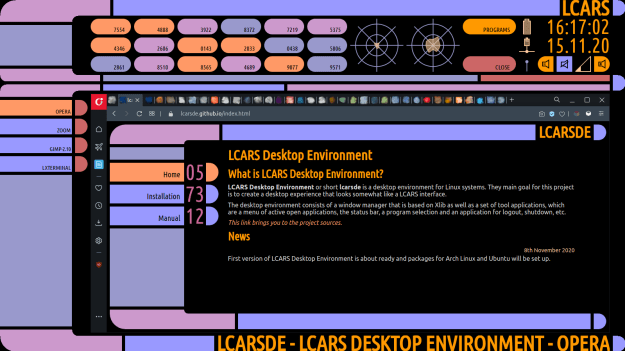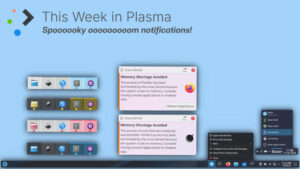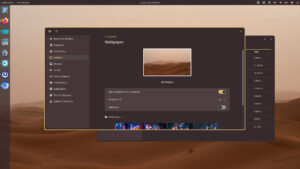We wonder what the crew from the Enterprise would think of 21st century Earthlings giving up Gnome, KDE, or Xfce for the official desktop environment of Star Fleet.

I’m not going to ask why they’re in 2022. I would say that it was some kind of side track from Star Trek: Picard, where an aged Picard visits Earth in 2024, but Wesley is still a teen wearing a Star Trek uniform, so it couldn’t be that. For some reason, they beam into my home office in rural North Carolina — Picard, Wesley Crusher, and of course Data.
About the same time they are materializing, I hit the blue button on Facebook and send a post that reads: “Picard would find it silly that we’re doing this. Data would find it fascinating, being more Vulcan than the Vulcans. Young Wesley would get into it, question perceptible changes which would be obvious, until he joined the New Age.” The post links to an article by Brian Lunduke, the ‘Linux Sucks’ dude, who’s an okay guy as long as he’s not talking politics, if you catch my drift.
Lunduke’s article, full of Star Trek: The Next Generation references, is about a desktop environment which is a near replica of the user interface on TNG, which evidently has a name, LCARS (for Library Computer Access/Retrieval System).
“The LCARS DE is not perfect,” Lunduke writes. “It doesn’t perfectly recreate an LCARS system… but it gets very, very close and does a surprisingly good job of finding ways of making traditional desktop components (like the status bar display) look like it would fit on the bridge of the Enterprise next to Mr Data.”
This got me wondering how Picard, Crusher, and Data would react to early computer age Earthlings trying to emulate a 24th century DE. I figure the story would have to start with some kind of unknown mission that has them visiting our time, and some kind of reason for them to need to beam down to the surface.
So I imagine them beaming down into my office, so I can try to figure out how they would react.
After they materialize, they at first seem perplexed, as if they haven’t arrived where they intended, but before they can say anything, Data notices the screenshot of the LCARS DE in Lunkuke’s article which is on the screen of my computer. He comes over to where I’m sitting, stares at the screen for a moment, points to the screenshot and asks, “Can you enlarge that image, please?”
“Yes,” I say.
I’d been looking at the article for a while, and had already learned that Lunduke has the page set up so that clicking on the image brings up a full screen view of it, which I did. Data studies the larger image for only a second (remember, his electronic brain or whatever it is can do quite a bit of thinking in a second) before saying, “Captain, this screen is a close replica of our LCARS screen. The resemblance is impressive, and exhibits interface usability knowledge that didn’t exist until the 24th century.”
Which brings Picard over, who politely asks if I mind if he leans in to look at the screen.
“How can that be?” he asks to no one in particular after taking a look. “Unless we jumped to the wrong time coordinates.”
“I have already checked, Captain,” Data says. “The coordinates are correct, and everything we have seen since we have been on the surface is consistent with our knowledge of early 21st century Earth.”
The look on Picard’s face grows more concerned.
“I wonder if some time travelers have corrupted the time line?” he asks, as if talking to himself. “If so, that could have dire consequences.”
“Indeed, it could sir,” Data agrees, then pauses for a second, lost in thought.
“It occurs to me there might be another explanation,” he says. “In this era there is a series of television shows…” He suddenly stops himself, and starts over with an explanation. “Television was a form of electronic audio-visual entertainment that was popular in the late 20th and early 21st centuries that…”
“Yes, I know what television is,” Picard interrupts with a bit of an eye roll. “Please continue, Mr. Data.”
“There was a series of television shows, a franchise they called it, that was so popular and had such an effect on Earth’s culture at the time that it served as the inspiration for Space Force, which as you know became Star Fleet with the advent of interstellar travel,” Data says. “It occurs to me that this might be an artifact from that show, which somehow became ingrained into the culture of Space Force/Star Fleet. So ingrained that it resurfaced centuries later, in our time, perhaps implanted subliminally on the user interface’s designer’s subconscious while studying primitive interface designs at Star Fleet Academy.”
Picard is deafeningly silent for a long moment, then turns to me and says, “Do you know this show…or ‘franchise,’ as Data calls it?”
“I do, it’s a favorite,” I say. “You’re in it, as is Data and Wesley Crusher.”
I expect a reaction from this tidbit of information. After all, wouldn’t it be weird to have a TV show about a distant future that has characters that actually exist in that future? The only reaction, however, comes from Crusher, who has been amusing himself by looking through my vinyl collection. Upon hearing his name, he turns to look over his shoulder at us briefly, but then returns to inspecting the cover art on the Moody Blues’ In Search of the Lost Chord album.
“And is this indeed an artifact from that franchise?” Picard asks, emphasizing the word “franchise.”
“Yes sir,” I say. “It’s not an exact copy, but a close replication.”
Picard doesn’t look pleased.
“So, we evidently have the people of this era to thank for an impossible-to-use abomination of an interface that’s been inflicted on us in the 24th century,” Picard says coldly.
Before I can respond, Data jumps in, sounding surprised.
“But Captain, LCARS represents a major advancement in usability. Certainly you understand that?”
“It’s too wordy data,” Picard answers, sounding exasperated. “You have to stop and read everything to find what you need to go where you want to go.”
“Hmm,” Data says. “I have no trouble navigating it at all.”
“You wouldn’t,” Picard answers, not impolitely. “You can read something like 200 words a second. We mere mortals aren’t quite so fortunate”
“That never occurred to me,” Data says. “I assumed…”
“I don’t know, I like it a lot,” Crusher interrupts, still holding the Moody Blues album. “I find it way cool. I like the color scheme, and the way everything’s overly organized.”
At that moment, we are interrupted by Picard’s communicator. I recognize the voice coming through the speaker as being Riker.
“Captain, sensors are picking up a vessel approaching at warp speed,” Riker says. “Its signature indicates it’s Romulan, who’ve probably detected our presence. I suggest you beam aboard so we can hightail it out of here and deflect their attention away from Earth.”
“Make it so, Number One,” Picard says, then turns to me and apologizes for any inconvenience they might have caused, as Crusher returns the album to the shelf.
“That’s music, right?” Crusher asks me. “Recorded electro-mechically, I’ve heard of that. The art on the cover speaks to me.”
“Yes, it’s music,” I answer. “I think you would like it. There’s one song in particular I think would resonate with you — ‘Thinking is the best way to travel.'”
Crusher looks confused for a moment, then a flash of recognition crosses his face.
“Bingo!” he says. “I think I know what I need to do now.”
And with that, they are gone. Beamed back aboard the Enterprise.
The daydream over, I return to my work.
Romance at short notice is my specialty.






